Capacitors in electronic circuits. Part 2. Interstage communication, filters, generators
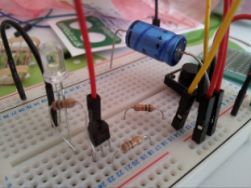 The most common use of capacitors is the connection between individual transistor stages, as shown in Figure 1. In this case, the capacitors are called transient.
The most common use of capacitors is the connection between individual transistor stages, as shown in Figure 1. In this case, the capacitors are called transient.
Transient capacitors pass the amplified signal and prevent the passage of direct current. When the power is turned on, the capacitor C2 is charged to the voltage at the collector of the transistor VT1, after which the passage of direct current becomes impossible. But the alternating current (amplified signal) makes the capacitor charge and discharge, i.e. passes through the capacitor to the next cascade.
Often in transistor circuits, at least in the audio range, electrolytic capacitors are used as transient ones. The rated values of the capacitors are chosen so that the amplified signal passes without much attenuation ...
Capacitors in electronic circuits
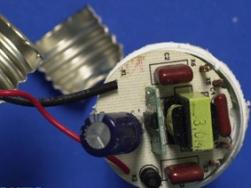 In previous articles, we briefly talked about the operation of capacitors in AC circuits, how and why capacitors pass alternating current. In this case, the capacitors do not heat up, power is not allocated to them: in one half-wave of the sinusoid, the capacitor charges, and in the other, it naturally discharges, while transferring the stored energy back to the current source.
In previous articles, we briefly talked about the operation of capacitors in AC circuits, how and why capacitors pass alternating current. In this case, the capacitors do not heat up, power is not allocated to them: in one half-wave of the sinusoid, the capacitor charges, and in the other, it naturally discharges, while transferring the stored energy back to the current source.
This method of passing current allows you to call the capacitor a free resistance, and that is why the capacitor connected to the outlet does not make the counter spin. And all this is because the current in the capacitor is ahead of exactly 1/4 of the time the voltage applied to it.
But this phase advance allows not only to “trick” the counter, but makes it possible to create various circuits, for example, generators of sinusoidal and rectangular signals, time delays and various frequency filters ...
Capacitors for AC electrical installations
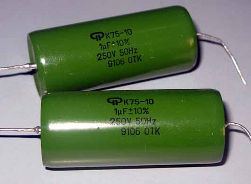 In the article "Capacitors: purpose, device, principle of action" was talked about electrolytic capacitors. They are mainly used in DC circuits, as filter capacities in rectifiers. Also, they can not do without decoupling power supply circuits of transistor cascades, stabilizers and transistor filters. Moreover, as was said in the article, they do not allow direct current, but do not want to work on alternating current.
In the article "Capacitors: purpose, device, principle of action" was talked about electrolytic capacitors. They are mainly used in DC circuits, as filter capacities in rectifiers. Also, they can not do without decoupling power supply circuits of transistor cascades, stabilizers and transistor filters. Moreover, as was said in the article, they do not allow direct current, but do not want to work on alternating current.
Non-polar capacitors exist for AC circuits, and many of their types indicate that the operating conditions are very diverse. In those cases when high stability of parameters is required, and the frequency is high enough, air and ceramic capacitors are used. The parameters of such capacitors are subject to increased requirements ...
Capacitors: purpose, device, principle of operation
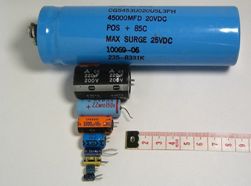 In all radio and electronic devices, except transistors and microcircuits, capacitors are used. In some circuits there are more of them, in others less, but there are practically no electronic circuits without capacitors.
In all radio and electronic devices, except transistors and microcircuits, capacitors are used. In some circuits there are more of them, in others less, but there are practically no electronic circuits without capacitors.
In this case, capacitors can perform a variety of tasks in devices. First of all, these are containers in the filters of rectifiers and stabilizers. With the help of capacitors, a signal is transmitted between the amplifier stages, low and high frequency filters are built, time intervals in the time delays are set, and the oscillation frequency in various generators is selected.
Capacitors derive their pedigree from the Leyden jar, which in the middle of the 18th century was used in their experiments by the Dutch scientist Peter van Mushenbruck. He lived in the city of Leiden, so it is easy to guess why this bank was called. Actually, it was an ordinary glass jar ...
The use of LEDs in electronic circuits
 Everyone is familiar with LEDs now. Without them, modern technology is simply unthinkable. These are LED lights and lamps, an indication of the operating modes of various household appliances, the illumination of screens of computer monitors, TVs, and many other things that you can’t even remember right away. All of these devices contain LEDs in the visible radiation range of various colors: red, green, blue (RGB), yellow, white. Modern technology allows you to get almost any color.
Everyone is familiar with LEDs now. Without them, modern technology is simply unthinkable. These are LED lights and lamps, an indication of the operating modes of various household appliances, the illumination of screens of computer monitors, TVs, and many other things that you can’t even remember right away. All of these devices contain LEDs in the visible radiation range of various colors: red, green, blue (RGB), yellow, white. Modern technology allows you to get almost any color.
In addition to LEDs in the visible range, there are LEDs for infrared and ultraviolet light. The main field of application of such LEDs is automation and control devices. It is enough to recall the remote control of various household appliances. If the first remote control models were used exclusively for controlling TVs, now they are used to control wall heaters, air conditioners ...
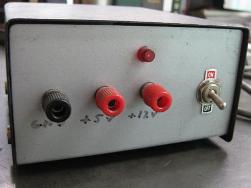 All electronic equipment is powered by direct current sources. For mobile equipment, batteries or galvanic batteries are typically used. Now there is plenty of such equipment in the hands and pockets: these are mobile phones, cameras, tablet computers, various measuring instruments and much more.
All electronic equipment is powered by direct current sources. For mobile equipment, batteries or galvanic batteries are typically used. Now there is plenty of such equipment in the hands and pockets: these are mobile phones, cameras, tablet computers, various measuring instruments and much more.
Stationary electronics - televisions, computers, music centers, etc. powered by AC using power supplies. Here, in no case can you do without batteries or small batteries.
Electronic devices are often not stand-alone and work on their own. First of all, these are built-in electronic units, for example, a control unit for a washing machine or microwave. But even in this case, the electronic units have their own separate power supplies, most often even stabilized ...
 In electronic technology, it is often necessary to measure direct currents. Apparently, for this reason, many multimeters, mostly cheap, can only measure direct current. The measurement range of alternating current is in some models of multimeters, which are more expensive, but these indications can only be trusted if the current has a sinusoidal shape and the frequency does not exceed 50 Hz.
In electronic technology, it is often necessary to measure direct currents. Apparently, for this reason, many multimeters, mostly cheap, can only measure direct current. The measurement range of alternating current is in some models of multimeters, which are more expensive, but these indications can only be trusted if the current has a sinusoidal shape and the frequency does not exceed 50 Hz.
Any measuring device is considered good if it does not introduce distortions into the measured quantity, or rather, introduces, but as little as possible. For a voltmeter, this is a high input impedance, since it is connected in parallel with a section of the circuit. It is appropriate to recall here that with a parallel connection, the total resistance of the section decreases. The ammeter is included in the break of the circuit section, therefore, for it, a low internal resistance is considered a positive quality, unlike a voltmeter. Moreover, the smaller the better, especially when measuring low currents ...
 In amateur radio practice, this is the most common type of measurement. For example, when repairing a TV, voltages are measured at characteristic points of the device, namely at the terminals of transistors and microcircuits. If you have at hand a circuit diagram, and it shows the modes of transistors and microcircuits, then it will not be difficult for an experienced master to find a malfunction.
In amateur radio practice, this is the most common type of measurement. For example, when repairing a TV, voltages are measured at characteristic points of the device, namely at the terminals of transistors and microcircuits. If you have at hand a circuit diagram, and it shows the modes of transistors and microcircuits, then it will not be difficult for an experienced master to find a malfunction.
When building self-assembled structures, stress measurement cannot be dispensed with. The only exceptions are the classic schemes, about which they write something like this: "If the design is assembled from serviceable parts, then no adjustment is required, it will work right away."
As a rule, these are classic electronics circuits, for example, a multivibrator. The same approach can be obtained even for an audio frequency amplifier, if it is assembled on a specialized chip ...
